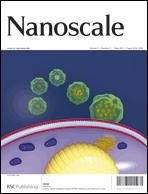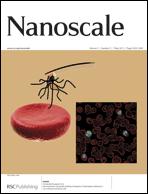This month sees the following articles in Nanoscale that are in the top ten most accessed for February:
Nanostructured carbon–metal oxide composite electrodes for supercapacitors: a review
Mingjia Zhi , Chengcheng Xiang , Jiangtian Li , Ming Li and Nianqiang Wu
Nanoscale, 2013,5, 72-88
DOI: 10.1039/C2NR32040A
Graphene transfer: key for applications
Junmo Kang , Dolly Shin , Sukang Bae and Byung Hee Hong
Nanoscale, 2012,4, 5527-5537
DOI: 10.1039/C2NR31317K
Graphene synthesis: relationship to applications
Rebecca S. Edwards and Karl S. Coleman
Nanoscale, 2013,5, 38-51
DOI: 10.1039/C2NR32629A
Graphene edges: a review of their fabrication and characterization
Xiaoting Jia , Jessica Campos-Delgado , Mauricio Terrones , Vincent Meunier and Mildred S. Dresselhaus
Nanoscale, 2011,3, 86-95
DOI: 10.1039/C0NR00600A
A review of fabrication and applications of carbon nanotube film-based flexible electronics
Steve Park , Michael Vosguerichian and Zhenan Bao
Nanoscale, 2013,5, 1727-1752
DOI: 10.1039/C3NR33560G
Advances in 2D boron nitride nanostructures: nanosheets, nanoribbons, nanomeshes, and hybrids with graphene
Yi Lin and John W. Connell
Nanoscale, 2012,4, 6908-6939
DOI: 10.1039/C2NR32201C
Upconversion nanoparticles and their composite nanostructures for biomedical imaging and cancer therapy
Liang Cheng , Chao Wang and Zhuang Liu
Nanoscale, 2013,5, 23-37
DOI: 10.1039/C2NR32311G
A facile route to synthesize multiporous MnCo2O4 and CoMn2O4 spinel quasi-hollow spheres with improved lithium storage properties
Jingfa Li , Shenglin Xiong , Xiaowei Li and Yitai Qian
Nanoscale, 2013,5, 2045-2054
DOI: 10.1039/C2NR33576J
Recent advances in the efficient reduction of graphene oxide and its application as energy storage electrode materials
Tapas Kuila , Ananta Kumar Mishra , Partha Khanra , Nam Hoon Kim and Joong Hee Lee
Nanoscale, 2013,5, 52-71
DOI: 10.1039/C2NR32703A
Recent progress in graphene-based nanomaterials as advanced electrocatalysts towards oxygen reduction reaction
Chengzhou Zhu and Shaojun Dong
Nanoscale, 2013,5, 1753-1767
DOI: 10.1039/C2NR33839D
Why not take a look at the articles today and blog your thoughts and comments below.
Fancy submitting an article to Nanoscale? Then why not submit to us today!
Comments Off on Top 10 most-read Nanoscale articles in February












 Jong Hak Kim and co-workers from Yonsei University report very impressive quasi-solid-state dye-sensitized solar cell (DSSC) efficiencies in
Jong Hak Kim and co-workers from Yonsei University report very impressive quasi-solid-state dye-sensitized solar cell (DSSC) efficiencies in 


 Scientists from Tsinghua University in China have found a way to synthesis water soluble nanocrystals with sizes smaller than 10nm using a formamide solvent-system.
Scientists from Tsinghua University in China have found a way to synthesis water soluble nanocrystals with sizes smaller than 10nm using a formamide solvent-system.
 A novel zinc oxide microwire optical resonator with parallelogram-shaped cross section has been made by chemists based in China and Taiwan. The material can effectively control light in two dimensions, and could play the part of a building block in the development of optoelectronic devices.
A novel zinc oxide microwire optical resonator with parallelogram-shaped cross section has been made by chemists based in China and Taiwan. The material can effectively control light in two dimensions, and could play the part of a building block in the development of optoelectronic devices.

 The State Administration for Foreign Experts Affairs (SAFEA) is a division of the Chinese Government with which RSC has a cooperation agreement. Under this agreement the RSC and SAFEA will jointly fund researchers from the UK to visit Chinese Universities. The purpose of the visits is to stimulate collaboration between UK and Chinese institutions. They will allow the visitor to contribute their experience towards the development of excellent emerging science and build links with the Chinese Chemistry community.
The State Administration for Foreign Experts Affairs (SAFEA) is a division of the Chinese Government with which RSC has a cooperation agreement. Under this agreement the RSC and SAFEA will jointly fund researchers from the UK to visit Chinese Universities. The purpose of the visits is to stimulate collaboration between UK and Chinese institutions. They will allow the visitor to contribute their experience towards the development of excellent emerging science and build links with the Chinese Chemistry community.